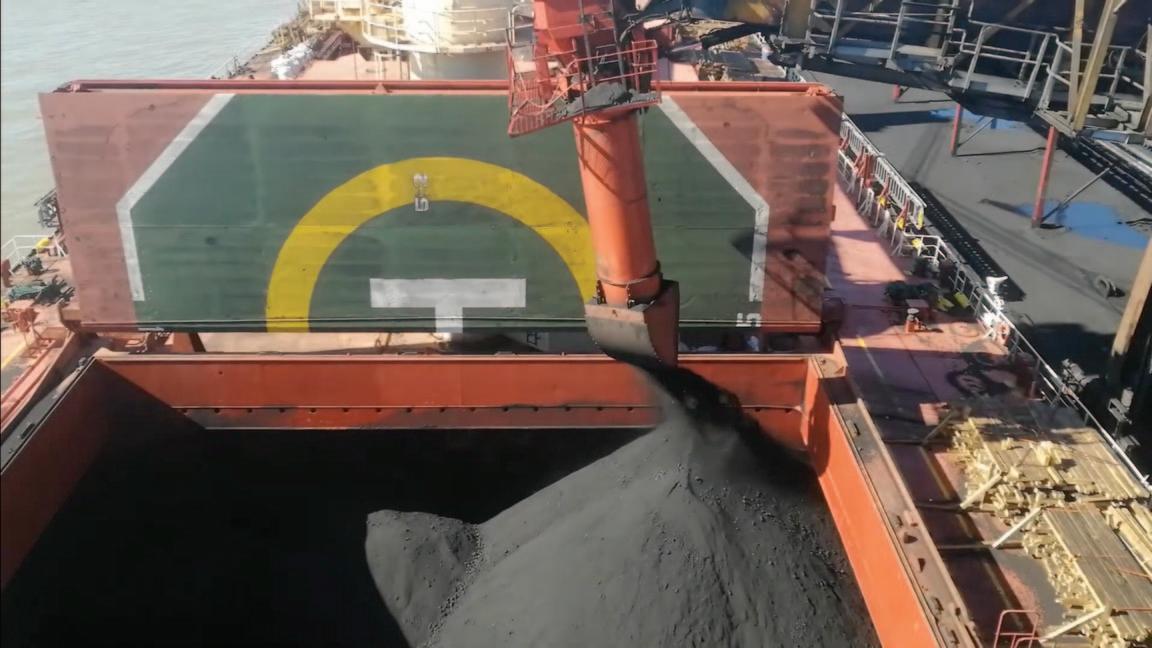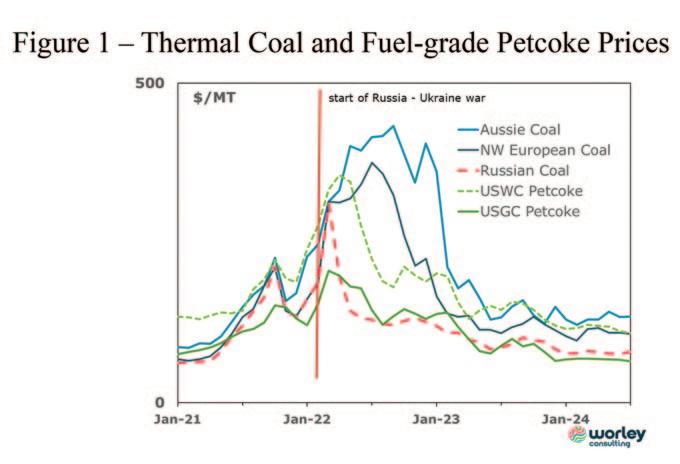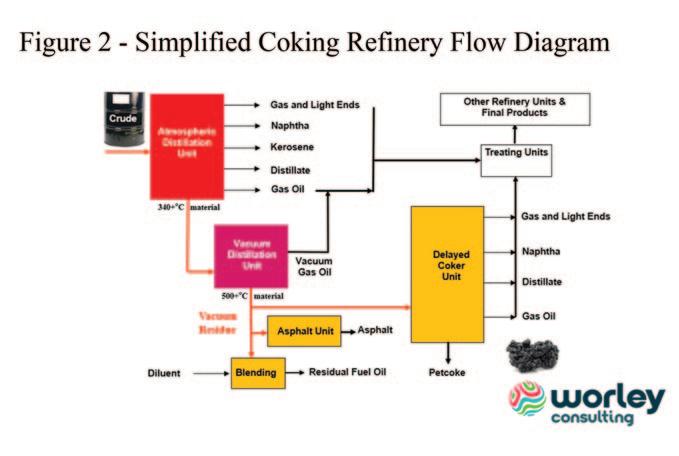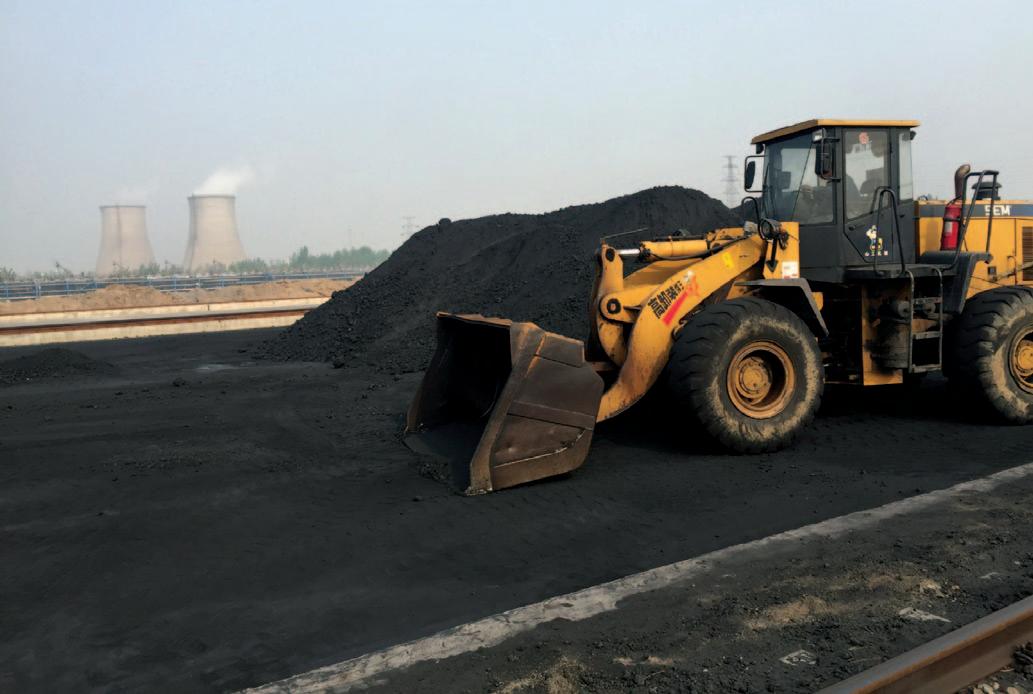
15 minute read
Petcoke market prices stabilizing, but trade flows changing
The petroleum coke (petcoke) market pricing has stabilized after four years of remarkable volatility (see Figure 1 — Thermal Coal and Fuel-grade Petcoke Prices), but this relative pricing stability masks significant underlying changes in trade flows that have occurred and are likely to continue into 2025. The historically high price volatility was driven by a multitude of factors including volatile coal prices, trade policies, and major geopolitical events such as the Covid-19 pandemic followed by Russia’s invasion of Ukraine. Almost simultaneously, with the implementation of Covid-19 lockdowns, there was a historic crash of oil prices in March 2020 followed by unprecedented oil production cuts by OPEC+ (12 OPEC countries + 9 non-OPEC countries led by Russia). So far in 2024 petroleum coke prices, especially US Gulf Coast (USGC) petcoke prices, have been very stable. Part of the stability can be attributed to more stable thermal (steam) coal prices because thermal coal pricing establishes the solid fuel pricing environment within which fuel- grade petroleum coke trades. However, in 2024 USGC fuel-grade petroleum coke prices have been more stable than Russian or especially Northwest European thermal coal prices, and USWC fuel-grade petcoke prices have been more stable than
Australian thermal coal prices.
We focus on United States fuel-grade petroleum coke export prices because US fuel-grade petcoke provides approximately 75% of seaborne petcoke trade. Fuel-grade petroleum coke has lower pricing and is generally lower quality than petcoke used for carbon applications (see Petroleum Coke Markets below for more information). Figure 1 illustrates that US West Coast (USWC) petroleum coke prices (unless specified otherwise, all references to petroleum coke prices refer to fuel-grade petcoke prices) are higher, sometimes substantially higher, than US Gulf Coast (USGC) petcoke prices. USWC petroleum coke prices are higher because USWC petcoke typically has much lower sulphur content than USGC petcoke (there are exceptions) which allows it to go into higher value markets like the steel and glass industries, and export volumes are much lower (<6 vs. 24+mt [million tonnes]), which makes it easier to limit sales to higher value markets. USWC exports are dominated by China and Japan which typically each receive about 40% of USWC exports. USGC export destinations are varied with shipments typically going to 40+ different countries in a year.





Before discussing changing trade flows, let us review a brief background on petroleum coke.
Coking Background
Petroleum coke is produced as a byproduct in many oil refineries. Crude oil is first processed in an atmospheric distillation unit, followed by a vacuum distillation unit. The heavy residuum exiting the bottom of the vacuum tower (i.e., vacuum tower bottoms, or VTB) can be used to make asphalt, residual fuel oil (RFO)1, or used as feedstock for a coker (see Figure 2 — Simplified Coking Refinery Flow Diagram) or other bottoms upgrading technology.
For decades, the refining industry has faced the problem that demand growth for transportation fuels (i.e., gasoline, diesel, jet fuel) has been, and continues to be, much greater than demand growth for RFO. To put it another way, people are buying cars and trucks and flying in airplanes, but no one is building RFO-fuelled power plants or industrial facilities. In response to this problem, the refining industry developed various technologies to upgrade VTBs to produce more valuable light products and eliminate the need to produce RFO.
Coking is the dominant bottoms upgrading technology. It allows refiners to reduce production of RFO per barrel of crude oil processed and bridge the gap between growth in demand for light products and RFO demand growth. To summarize, the primary purpose of a coker is to reduce the production of residual fuel oil by converting heavy VTBs into high value transportation fuels (gasoline, diesel, jet fuel, etc.) with petroleum coke produced as a by-product of the coking process.

It is also important to recognize that the percentage of VTBs produced as a result of refining crude oil increases dramatically as the crude oil processed in the refinery gets heavier (i.e., lower specific gravity). For example, about 10% (by weight) of light Arabian crude oil becomes vacuum tower bottoms, whereas almost 40% of very heavy Mexican Maya or Alberta crude oils become vacuum tower bottoms. Consequently, the percentage of crude oil that converts into petroleum coke increases dramatically, as crude oil gets heavier, and refineries that are designed to process heavy crude oils are much more likely to have coking capacity (or other VTB upgrading technology) than refineries designed to refine lighter crude oil.
Petroleum Coke Production
Traditionally, cokers are installed in oil refineries to convert VTB and other heavy residual oils into higher-value light transportation products (e.g., gasoline, jet fuel, diesel fuel). Until recently, a coker almost invariably increased refinery profitability because the yield of high-value transportation fuels is maximized and the production of low-value RFO is minimized2. While the coking process has been in use since the 1930s, petroleum coke production saw its largest growth between 1995 and 2018 (production: 1995= ~30mt, 2018 =~140mt) principally because light transportation petroleum product demand grew faster than RFO demand worldwide and the overall global crude slate got heavier. Consequently, petroleum coke production grew much faster than crude oil demand (1995–2018 CAGR = 6.6% for petcoke vs. 1.6% for crude oil).
However, recently petroleum coke production growth has slowed markedly because crude oil, on average, is getting lighter and the recent move for refineries to be configured for oil to chemicals production. Two factors have been driving crude oil, globally, to be lighter. The first is due to increased production of tight light oil (TLO), particularly in the United States, as a result of the fracking revolution. The second reason is crude oil production cuts by OPEC+.
US crude oil production has increased significantly, mostly because of the rise in tight light oil (TLO) share. US crude oil production increased from 5.5 million barrels per day (mbpd) in 2010 to 13mbpd in 2023 and is further projected to grow to ~14mbpd by 2025 and remain almost the same through 2030. This dramatic increase of US crude oil production has been driven by TLO production, which increased from ~0.5mbpd in 2010 to ~8.9mbpd in 2023 and is expected to increase another 20% to ~10.6mbpd by 2030, primarily from the Permian Basin in Texas. The share of TLO is seen rising from ~9% in 2010 to ~69% in 2023, and to over 75% by 2030. Offshore production from the US Gulf of Mexico is expected to peak at 2.1mbpd in 2026 and will then retreat to 1.8mbpd in 2030.
1. Typically, about 30% high value diluent such as light cycle oil needs to be added to meet RFO viscosity and density specifications.
2. Since the early 1990s cokers have also been used in upgraders that produce various grades of synthetic crude oil (SCO) from bitumen or ultraheavy crude oils. This type of upgrader exists in Venezuela where ultra-heavy Orinoco Belt crude oil is upgraded and is exported as lighter crude oils, and in Canada where upgraders are used to produce SCO from the bitumen derived from Alberta oil sands. Upgrading economics are driven by crude oil economics, not refining and coking economics.

Refineries run a blend of different crude oils (known as the crude slate), and choices of crude oils which are in the crude slate significantly impacts the quantity and quality of petroleum coke that is produced. The selection of crude slate is driven by a complex series of factors including the capacities and capabilities of the various processing units within the refinery, the expected operating state of various processing units, crude oil pricing and availability of different qualities of crude oil, and demand for various refined products.
Increasing TLO share of crude oil production makes the crude slate lighter — hence lower petroleum coke production. In parallel, with the shortage of heavy crude oil, because of the OPEC+ cuts, US exports of lighter crude oil, mostly to the European refiners, have turned the crude slate lighter elsewhere.
Global petroleum coke production dropped by almost 10% in 2020 due to governments’ policies implemented in response to the Covid-19 pandemic and the indirect impact of sharp OPEC+ production cuts. Production partially rebounded in 2021. Production growth accelerated in 2022, and production slightly exceeded pre-pandemic levels (see Figure 3
— Petroleum Coke Production).
Production grew almost 5% in 2023 and is expected grow about 3% in 2024.
After the price war between Saudi Arabia and Russia, which led to the oil price crash in March 2020, OPEC+ members decided to impose a historic production cut, equivalent to 10% of global oil demand, which, after succeeding extensions, came to end in August 2022. However, subsequent to the meetings, OPEC+ members decided to implement 3.66mbpd of oil production cuts and additional voluntary cuts of 2.2mbpd over and above 3.66 mbpd cuts3 Most recently, the OPEC+ members decided to extend the 3.66mbpd cuts until the end of 2025, while the voluntary additional cuts amounting to 2.2mbpd will phase out from October 2024 onwards, though the group maintains that the phase out will depend upon the market conditions and could be paused or even reversed. Total cuts, which as we write, amounts to ~5.8mbpd or equivalent to 6% of the global oil demand.
OPEC producers tend to preferentially cut heavy oil production when they make production cuts in order to maximize revenue as heavy crude oil sells at discounts to light crude oil. This preferential cutting of heavy crude oil causes a relative shortage of heavy crude oil, and the discount for heavy crude oil tends to shrink. The shrinking discount for heavy crude oil hurts the profitability of coking and tends to induce coking refineries to migrate to lighter crude slates. Petroleum coke production reduces with lighter crude slates. Generally, but not always, lighter crude oils have lower sulphur content, which reduces petroleum coke sulphur content.
Petroleum Coke Markets
Petroleum coke is unusual because it is used not only as a heat source (i.e., fuel) but also as a carbon source in metal production and chemical processes. Petroleum coke that is used as a carbon source requires better quality (e.g., low sulphur and metals content) and commands a higher value, driven by different factors than fuel-grade petcoke prices.
Green4 petroleum coke is usually upgraded by calcination when it is used as a carbon source. Calcination is a process that uses heat [1,150-1,350°C (2,102–2,462°F)] to remove moisture and volatile matter from petcoke, improves critical physical properties, and converts green petcoke into an electrically conductive form of carbon. Green petcoke that has been calcined is referred to as calcined petroleum coke (CPC). The largest market for CPC is in the production of carbon anodes for aluminium smelting. Other uses for CPC are in the production of carbon electrodes for electric arc furnaces, titanium dioxide (TiO2) production, as a recarburizer (i.e., carbon raiser) in the iron and steel industry, and, very recently, as a source of synthetic graphite in lithium-ion (Li-ion) battery production. A little over 30% of petroleum coke that is produced is sold into these higher value-added markets for higher quality petcoke; the remaining production is used as a fuel source. The carbon source market share has been growing recently as demand in these markets has been growing faster than overall petroleum coke production.
4. Technically, all petcoke that has not been calcined is green petcoke (GPC). However, within the petcoke industry, the term GPC is usually only used for petcoke that is used as calciner feedstock. Unless otherwise noted, discussion of petcoke or petroleum coke will be referring to green (i.e. not calcined) petroleum coke.

Fuel-grade petroleum coke is used in a variety of industries — primarily as a substitute for coal, but sometimes as a substitute for fuel oil. Petroleum coke has higher calorific value (i.e., kcal/kg) and much lower ash content than coal. However, it is more difficult to burn, generally has higher sulphur content, and is often more difficult to pulverize5 than coal because most fuelgrade petroleum cokes are harder than coal, so it typically sells at a discount to coal. The cement industry is the largest consumer of fuel-grade petroleum coke because cement kilns are particularly well suited to burn petcoke, and cement kilns inherently capture approximately 90% of the sulphur oxides (SOx) emissions resulting from burning petcoke. The next largest demand segment for fuel-grade petroleum coke is the ‘other industry’ category, which includes lime6, brick, calcium carbide, and glass production, plus gasification of petcoke to produce chemicals (e.g., ammonia, urea ammonium nitrate, etc.). The remaining categories in declining market size are power generation, long-term storage, and iron & steel production. The ‘long-term storage’ category refers to petroleum coke produced as a by-product of upgrading bitumen (primarily Western Canadian oil sands) where petcoke is placed underground as part of the reclamation process associated with open cast (open pit) mining of bitumen or was placed in long-term storage in Venezuela because dependability problems at petcoke terminals located at the Port of Jose prevented exports of petroleum coke from keeping up with petcoke production.
SHIFTING PETROLEUM COKE TRADE FLOWS
Venezuela re-emerged in 2021 as an exporter of petroleum coke as petcoke from the huge (estimated at 18mt+) inventory located near the Port of Jose began to be loaded onto vessels. Less than 0.3mt were exported in 2021, but export volume shot up to almost 3.2mt in 2022. Exports during the first seven months of 2023 were running at the equivalent annual rate of about 4.7mt/year. Then contract disputes between Maroil, the primary exporter, and Petróleos de Venezuela, SA (PdVSA) caused exports to only average about 80,000 tonnes/month from August through November. In October, the US Department of State issued sanctions relief on Venezuela’s oil industry in return for the Maduro government lifting bans on opposition political candidates, other political reforms, and release of detained US citizens. Shortly thereafter, exports of Venezuela petroleum coke rebounded as globally Venezuela import volumes averaged just under 0.5mt/month from January 2024 through April. US sanctions relief expired April 18 because the US said the Maduro government had failed to abide by the terms of the agreement. Subsequently, vessel loadings have slowed with an average of 0.25mt/month being loaded in June and July.

Historically, three key export markets for US petroleum coke have been China, India, and Turkey, but trade flows changed in the last year and are likely to change shortly due to probable changes in China’s regulations regarding the use of petroleum coke.
China’s petroleum coke imports surged during the first four months of 2023, 73% more than the first four months of 2022, even though China imported a record 14.mt of green (non-calcined) petcoke in 2022. During this same period, China’s domestic petroleum coke production was also up (+10%) versus 2022. The combination of surging import volumes, increased domestic production, and somewhat lacklustre demand caused petroleum coke inventories to surge to 6.5mt+.
Import volumes reduced in May and June, and monthly imports reduced further during the second half of 2023 to ~20% less than in the second half of 2022. Inventory levels decreased as 2023 proceeded, but inventory levels at the end of 2023 remained at very high levels by historical standards. For the year, China imported 16mt of petroleum coke, continuing the recent trend of setting new record high import volumes each year.
The sources of China’s petroleum coke imports have changed markedly since 2021 (see Figure 4 – China Green Petroleum Coke Imports). Imports from the United States trended down some in 2023 and the downward trend accelerated during the first six months of 2024. Simultaneously, imports from the Kingdom of Saudi Arabia (KSA) were up in the second half 2023 and during the first half of 2024. These trends can at least be partially attributed to vessel transit restrictions put in place by the Panama Canal Authority during the later part of 2023 and the first half of 2024 to conserve water as a result of severe drought conditions in Panama. The vessel transit restrictions significantly increased the cost for vessels transiting the Panama Canal. Vessels carrying USGC petroleum coke typically transit through the Panama Canal when going to China but transit the Suez Canal when going to India. Thus, the Panama Canal vessel restrictions put USGC petroleum coke to China at a freight disadvantage compared to USGC petcoke to India moves.
5. Coal (and petcoke) is typically pulverized to approximately the consistency of talcum powder to facilitate the pulverized (suspension) fuel combustion process used in the power, cement, lime, and many other industries.
6. Lime kilns are very similar to cement kilns and have the same inherent capabilities to successfully burn petcoke as cement kilns.


Typically 90% of KSA’s petroleum coke production is exported to China and India. The higher shipping costs from the USGC to China provided a comparative freight advantage to Saudi Arabia. Consequently, a higher percentage of KSA petroleum coke was shipped to China while USGC to India shipment volumes increased.
Imports of Russian petroleum coke in 2023 were 2.5 times larger than they were in 2021 and they are on track to increase another 30% in 2024. Russian petroleum coke exports to China surged after the EU sanctioned Russian energy products (including petcoke) as Russia redirected its petroleum coke exports from the EU to China. The bulk of these shipments are made by rail, not ocean transport.
Imports of petroleum coke from Latin America (excluding Venezuela) increased 50% in 2023, primarily driven by a sharp rise in exports from Brazil to China. The three primary Latin American exporting countries are Argentina, Brazil, and Colombia. These are low sulphur petroleum cokes; petcokes from Argentina and Brazil are very high quality and are in demand as calciner feedstock. Imports from Latin America are on track to be about the same in 2024 as 2023, as decreased imports from Brazil are being offset by increasing imports from Argentina and Colombia.
Year to date through June, China imported 0.5mt of Venezuelan petroleum coke, 75% less than the 2mt imported during the first six months of 2023. Some of this decrease could be attributed to the Panama Canal freight impact that impacted USGC petroleum coke exports to China, but other factors discussed previously also influenced the sharp drop in imports of Venezuelan petcoke.
It is likely that imports of high sulphur petroleum coke into China will be lower in the second half of 2024 than they were in during the first half of 2024 because on 30 May, China’s government published a plan stating that “….high-sulphur petroleum coke shall not be used as fuel...” Presumably this plan will not impact use of high sulphur petroleum coke for process use (e.g., calcining to produce calcined petroleum coke for the aluminium industry or silicon carbide production). It should be noted that while the notice is titled ...“2024–2025… Plan”, it is clear many elements of the plan such as “Accelerate the construction of large-scale wind power and photovoltaic bases with a focus on desert, Gobi and wasteland” will take years to implement. There are many uncertainties regarding the ban on using high sulphur petcoke as fuel including:

What is the definition of high sulphur v petroleum coke?
Will enforcement be via a large tax or v an outright ban?
What will be the implementation v timeline?
How will high sulphur petroleum coke v for process use be differentiated from high sulphur petcoke for fuel use?
So far China’s announcement has had little impact on the USGC petroleum coke market as very little high sulphur USGC petroleum coke was being exported to China. One concern is that exports of petroleum coke produced in the KSA, which is very high sulphur, to China will be greatly restricted and will end up competing with USGC petroleum coke in the Asian market, especially India. Another concern is that Venezuela petroleum coke that would have been sold to China will also end up competing in the Asian market (especially India) with USGC petcoke.
India’s petroleum coke imports year to date through May 2024 totalled ~6.7mt, which is a record high for the same period as compared with previous years. Annualizing the YTD through May 2024 numbers, India’s petroleum coke imports may reach a record high ~16mt in 2024, breaching the previous high of ~13.2mt in 2016 and up from ~11.5mt in 2023. See Figure 5 – India Green Petroleum Coke Imports

Petroleum coke imports into India are regulated and regularly monitored. This year, the anode-grade GPC imports quota for Indian calciners has been increased from 1.4mt/year to 1.9mt/year. Calcined petroleum coke (CPC) imports will be increased from 0.5mt/year to 0.8mt/year for Indian Fiscal Year 2025-2026 (i.e., April 2025 to March 2026) onwards. Earlier, in April 2023 integrated steel plants were allowed to import low sulphur petroleum coke for blending with coking coal, and in June 2023 importation of needle petroleum coke for the production of synthetic graphite for Li-ion battery anodes was allowed.
Turkey’s petroleum coke imports during the first half of 2024 are ~130% higher (~2.3 times higher), at ~2.2mt than the same period in 2023, and petcoke imports are on track for record high ~4.4mt. Because of the earthquake that hit southern and central Turkey in February 2023 coupled with a significant rise in thermal coal imports, petroleum coke imports in 2023 fell 20% versus 2022, to ~2.5mt.


Summary
The petroleum coke market has returned to close to historical pricing levels, which is a strong indication that the petcoke market is moving beyond the disruptions of the last several years. Production will grow in 2024 to record high levels but at a slower rate than in 2023. Trade flows have changed due to various factors. The biggest uncertainty in the near term is China’s policy regarding the use of high sulphur petroleum coke.
LONGER TERM OUTLOOK – PETROLEUM COKE MEGATRENDS
Developments in specific industries as well as the evolution of the energy transition are expected to significantly shape the petroleum coke industry going forward. We refer to these developments as petcoke megatrends and are summarized as follows:
Pace of the energy transition from oil- v based transportation fuels to renewable fuels and electric vehicles; Repurposing of petroleum refining v assets to renewable fuel production; Permanent shut down of marginal v refineries; Refineries pursuing oil to chemicals v strategy, which typically does not involve the installation of a coker; Increased demand for synthetic v graphite produced from petroleum coke for battery production to support increased use of electric vehicles and renewable power generation; Growth in aluminium production v (primary and recycled); Inert anode (also known as ‘carbon v free’) aluminium smelting technology (eliminates current need for calcined petroleum coke in consumable anodes).
Each of these trends will have a different impact on petcoke production or consumption and the net effect will determine the future course of petroleum coke.
These megatrends will be discussed in more detail at our upcoming Fall Petcoke Forum and our 23rd Annual Petcoke Conference in March 2025.










